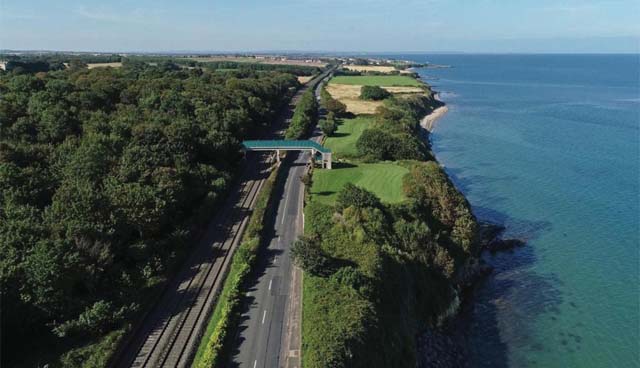Tourism in Fingal

2022 marks the final years of Fingal’s 2017–2022 tourism strategy. The sector plays an important role in the local economy, generating €500 million in annual spend and sustaining 20,000 jobs across all sectors, a quarter of total jobs in the county.
Tourism in Fingal is said to be heavily dependent upon both day-trip visitors, taking in the county’s coastal locations and heritage sites of interest, and stay-over visitors who are mainly concentrated on Dublin Airport and the surrounding area. An estimated 8,000 businesses provide accommodation and catering services in Fingal, with guest accommodation supporting an estimated 3,000 full time job equivalents and catering providing another 2,000.
In 2017, Fingal County Council published its Fingal Tourism Statement 2017–2022, a strategy laying out a total of 152 actions in order to make Fingal an “attractive, vibrant and sustainable tourism destination delivering a distinctive experience for local residents, domestic and international visitors”. The 152 actions fall under three main headings: optimise and expand visitor experiences; adopt a new place marketing strategy align with, and leveraging, the Grow Dublin Tourism Alliance; and develop new ways of working in partnership with stakeholders.
Actions taken before the publication of the strategy in 2017 included a strategic review of heritage properties in 2016, with work then following on the streamlining of internal management arrangements in these properties, the improvement of transitional business performance, the construction of a strategic investment strategy, the appointment of a Heritage Task Force and the creation of a single management entity for the eight heritage properties based on an open charitable trust model.
Fingal County Council operates five heritage properties under its ownership as community and tourism attractions. These five properties are: Swords Castle, Malahide Castle and Gardens, Newbridge House and Farm, Skerries Mill, and Ardgillan Castle. The council operates an annual programme of 64 events and festivals throughout the county, which are estimated to generate over €30 million per annum and support 360 jobs annually.
A major plank of the tourism strategy is the improvement of connectivity both to and within the area, with nine actions outlined to improve Fingal’s performance in this area, from the deliverance of a tourist bus around the area, including Dublin Airport, to the completion in incremental segments of the Fingal Coastal Way and the support of Waterways Ireland in the delivery of the Royal Canal Greenway.
One increment of the Fingal Coastal Way that has been earmarked under funding received from the Urban Regeneration and Development Fund (URDF) is the Castle to Castle Cycleway, to run from Bremore Castle in the northern reaches of Balbriggan to Ardgillan Castle and Demesne in southern Balbriggan. The Fingal Coastal Way, when complete, will be a greenway extending from Newbridge Demesne in Donabate to the Fingal county boundary, to the north of Balbriggan, with a final length of approximately 32km.
The Coastal Way is “envisaged to be a flagship scheme for tourism in the county with the potential to promote and enhance the local tourist economy”. Active tourism amenities such as greenways are proving evermore popular in Irish tourism and are becoming boons to the local economy. A Fáilte Ireland report in 2019 estimated that the Newport to Mulranny section of the Great Western Greenway in Mayo would contribute €7.2 million to the local economy per year.

Government investment in greenways is headlined by the €53 million Greenways Development Strategy, while the 2021 Budget saw the “highest single-year amount ever allocated to greenways”, €63.5 million. The power of their attraction is exemplified by the Waterford Greenway, which a 2019 study revealed had been visited by over 280,000 tourists, 68 per cent of whom had said that the greenway was their main motivation for visiting Waterford. The numbers of tourists coming to Ireland for walking and cycling holidays saw a significant rise from 371,000 to 1.8 million in 2017. In 2018, 46 per cent of all overseas holidaymakers to Ireland “engaged in walking and cycling as part of their holiday experience”. Adventure tourism, which includes water sports, hiking, mountain biking, adventure photography and nature watching and is easily catered for within Fingal’s coastal regions and rural hinterlands, was said to be worth €1.2 billion to the Irish economy overall in 2018.

With the global tourism sector looking to begin its bounce back from the damage wrought by Covid-19 in 2022, Fingal is no different. €1.2 million of Fingal County Council’s €300 million budget for the year has been pledged towards the sector, which will be boosted by the return of the highly popular Flavours of Fingal festival in July and further work being done on the development of Swords Cultural Quarter. In January 2022, Fingal County Council invited applicants organising festivals and events to apply for financial assistance in three strands totalling maximums of €4,500, €7,500 and €15,000.
Fingal’s Director of Tourism and Cultural Development at Fingal, Emer O’Gorman said: “We know that supporting events and festivals right across Fingal not only has an economic benefit, but that it also helps to better connect communities and enrich people’s lives. That will be particularly important as we look to shake off the extremely challenging times we’ve all faced and begin to look forward to an exciting calendar of events to enjoy next year.” With the delivery of a new runway in Dublin Airport also to come in the near future and to bring with it more visitors to the area, tourism in the area appears ready to begin its recovery.





